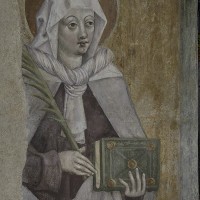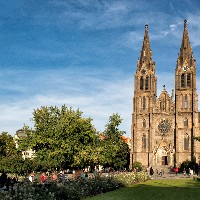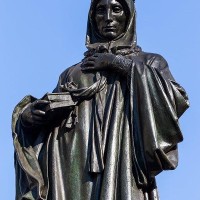Breadcrumbs navigation
Prague places that commemorate St Ludmila
Although the focus of the 1100th anniversary of the assassination of St Ludmila centres on Tetín castle, where Ludmila was murdered on September 15, 921 at the behest of her daughter-in-law Drahomíra, commemorative events are being held throughout the Czech Republic, and Prague is no exception. So let us go to the places in Prague that remind us of St Ludmila.
Ludmila’s mortal remains were transferred soon after her death from Tetín to Prague by her grandson Wenceslas. Her tomb in St George's Church became part of the first Benedictine convent. The nuns, often members of the Přemyslid dynasty, thus became guardians of the reverential cult of their great ancestor and guardians of her grave, which was initially close to the main altar. The tomb was moved around 1300 to the preceding main altar, on an upraised choir. Some of her mortal remains were then removed and placed in separate reliquaries – notably her upper limbs and skull. Ludmila’s relics were transferred yet again in the 1370s to their present place – the separate Chapel of St Ludmila in the southern nave of St George's Basilica, and covered over by a very substantial tombstone.
 The skull of St Ludmila
The skull of St Ludmila
In addition to exceptional events, this rare relic is displayed for reverence only one day a year, on the feast day of St Ludmila on September 16th at Prague Castle. For the rest of the year, the relics are stored in the treasury of St Vitus Cathedral in an honourable place near the skulls of St Adalbert and St Wenceslas.
At Prague Castle we can also see another place where Ludmila’s footsteps certainly must have led during her husband’s life. As one legend about the life of St Ludmila relates, after returning to Bohemia from exile in Moravia, he had 'arranged, as he had sworn in exile, that a temple be built in honour of the blessed Virgin Mary in the city of Prague'. The Church of our Lady, founded by Bořivoj I. before 885, it is the oldest Christian church in Prague. The preserved northern part of the church is located in the Prague Castle Picture Gallery in the vicinity of the passageway between the II. and IV. Castle courtyards. The remains of the church can be seen from a vantage point along the afore mentioned passageway or through a window from the Picture Gallery.
 Until 1784, the ramp of Prague Castle was adorned with a statue of St Ludmila with the boy Wenceslas by Matthias Bernard Braun, sculpted after 1720. As a consequence of a flood, when the Vltava river damaged the eighth pillar of Charles Bridge, including the statue of St Wenceslas, the statue of St Ludmila teaching little Wenceslas to read was chosen as a suitable substitute. A relief on the pedestal depicts Wenceslas’ assassination. The sandstone statue is the eighth on the right as we cross along Charles Bridge from the Lesser Town Bridge Tower. Since 1999, we shall only find its copy here, but we can still go and see the original at the Gorlice Hall of the Vyšehrad casemates.
Until 1784, the ramp of Prague Castle was adorned with a statue of St Ludmila with the boy Wenceslas by Matthias Bernard Braun, sculpted after 1720. As a consequence of a flood, when the Vltava river damaged the eighth pillar of Charles Bridge, including the statue of St Wenceslas, the statue of St Ludmila teaching little Wenceslas to read was chosen as a suitable substitute. A relief on the pedestal depicts Wenceslas’ assassination. The sandstone statue is the eighth on the right as we cross along Charles Bridge from the Lesser Town Bridge Tower. Since 1999, we shall only find its copy here, but we can still go and see the original at the Gorlice Hall of the Vyšehrad casemates.
We can also stop to admire a statue of St Ludmila on Wenceslas Square, where she has accompanied her grandson St Wenceslas since 1912 together with three other Czech patrons. The monument was created by sculptor Josef Václav Myslbek. He is said to have worked on it for more than 30 years, with the figures of saints being progressively added to that of St Wenceslas on horseback. The first was Saint Ludmila, standing at the front left, then Procopius at the front right, then Agnes (behind Ludmila) and the last saint added was Adalbert, as late as May 1925, almost 3 years after Myslbek's death.
Prague's Neo-Gothic Church of St Ludmila on Náměstí Míru square in Vinohrady. The three-nave basilica of unplastered brickwork with a transverse cruciform nave was built after the Royal Vinohrady conurbation on the initiative of municipal councillors, to designs by architect Josef Mocker. The Church, dedicated to St Ludmila was ceremonially consecrated on October 8, 1893.
 The saint herself is depicted here in several places: in the highest niche of the church frontage, in the right niche of the main portal as well as in Myslbek's relief above the entrance staircase. In the opulent interior we find Ludmila in, e.g. a painting among the figures of saints, in a series of seven paintings from the life of St Ludmila in the presbytery under the window ledge, or in her full gilded glory with a halo looking down from the main altar. As well as appearing in other stained glass, an entire monumental glass window is devoted to describing the plot of her death.
The saint herself is depicted here in several places: in the highest niche of the church frontage, in the right niche of the main portal as well as in Myslbek's relief above the entrance staircase. In the opulent interior we find Ludmila in, e.g. a painting among the figures of saints, in a series of seven paintings from the life of St Ludmila in the presbytery under the window ledge, or in her full gilded glory with a halo looking down from the main altar. As well as appearing in other stained glass, an entire monumental glass window is devoted to describing the plot of her death.



